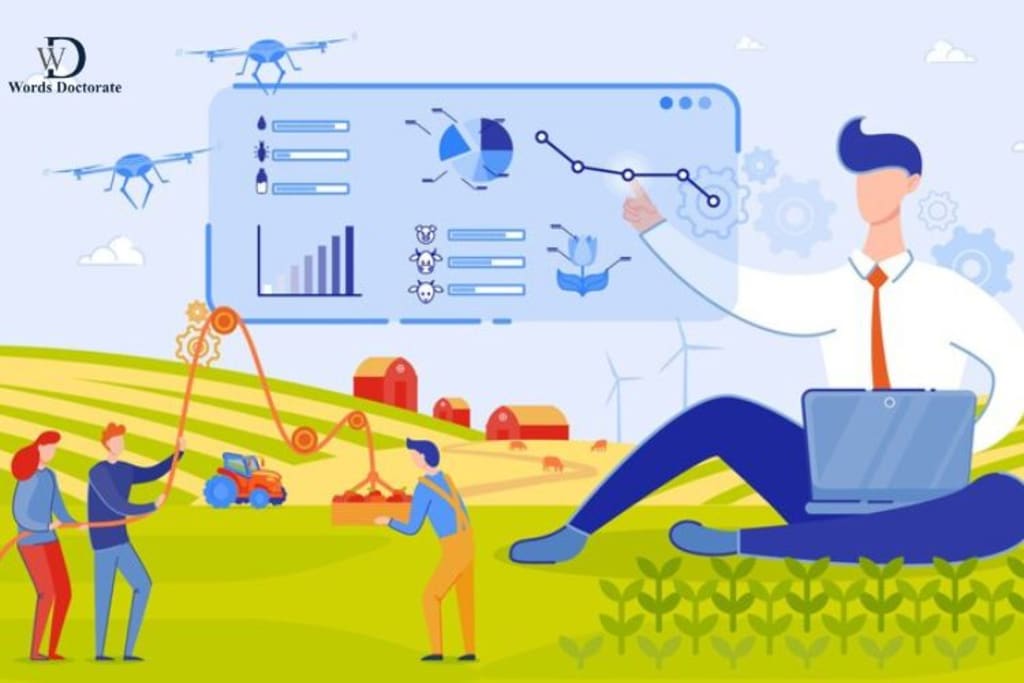Leveraging Big Data In Agriculture: A Review Of Recent Developments And Applications In AI Ahmadi, Kenya
Big Data In Agriculture

Abstract:
As it embraces the possibilities of big data and artificial intelligence (AI) technology, Ahmadi, Kenya's agriculture sector is poised for transformation. The agricultural value chain is producing enormous amounts of data due to the advent of digitization, ranging from supply chain logistics and market analysis to farm management and crop monitoring. This study examines how big data research in agriculture is changing in Ahmadi, Kenya, in relation to artificial intelligence (AI), emphasizing the field's importance, difficulties, most recent developments, and potential future paths.
Introduction:
Thanks to developments in big data analytics and artificial intelligence, Ahmadi, Kenya, a city known for its agricultural past, is experiencing a paradigm shift in the way farming is done. The combination of technology and agriculture offers previously unheard-of chances to boost resilience, sustainability, and production in the face of issues with global food security and climate change. This study explores the application of big data research to agricultural innovation, with a particular emphasis on Ahmadi, Kenya.
Significance Of Big Data In Agriculture:
With its actionable insights that may transform decision-making and maximize resource allocation, big data has come to light as a game-changer in agriculture. In Ahmadi, Kenya, where the economy is based primarily on agriculture, the need for big data research is immense. Farmers and other stakeholders are able to make well-informed decisions about crop selection, irrigation scheduling, pest management, and market forecasts by utilizing data from sources like satellite imaging, weather stations, soil sensors, and market trends.
Challenges In Ahmadi, Kenya's Big Data Research:
In the setting of Ahmadi, Kenya, big data research in agriculture faces a number of difficulties despite its enormous potential. Data transmission and gathering are hampered in rural areas by a lack of digital infrastructure and dependable internet connectivity. Furthermore, a hurdle to the widespread adoption of big data solutions is the high cost of technology adoption combined with farmers' limited digital literacy. In addition, worries about data security, ownership, and privacy call for strong legal frameworks and moral standards to protect farmers' interests.
Recent Developments And Uses:
Scholars and professionals in Ahmadi, Kenya, have made great progress lately in utilizing big data for agricultural purposes. To extract useful insights from a variety of datasets, advanced analytics approaches including machine learning, predictive modeling, and remote sensing have been used. Predictive analytics models, for example, have been created to foresee pest infestations and agricultural diseases, allowing for early mitigation and intervention. In a similar vein, big data analytics-driven precision agricultural methods have completely transformed farm management strategies, improving resource efficiency and optimizing productivity.
Future Directions And Opportunities:
Looking ahead, Ahmadi, Kenya has a lot of potential for big data studies in agriculture. The development of creative solutions suited to the requirements of smallholder farmers can be facilitated by cooperative efforts between the government, academic institutions, stakeholders in the corporate sector, and development partners. Farmers may fully utilize big data by implementing programs that improve digital literacy, make inexpensive technological solutions accessible, and encourage data-driven decision-making. Additionally, funding for R&D, when paired with encouraging laws and incentives, can spur entrepreneurship and innovation in the agri-tech industry, promoting sustainable development and economic success.
Latest Advancements In Big Data Applications For Agriculture In Kenya
The following are the most recent developments in big data applications for Kenyan agriculture:
Machine Learning: To evaluate massive information and offer insights on crop yields, weather patterns, and pest control, machine learning techniques are being deployed.
Weather Stations: Farmers use weather stations to gather current weather information, which helps them make informed decisions and manage their crops more effectively.
Database Systems: To help farmers make better decisions, database systems are being used to store and analyze vast volumes of data on crop yields, soil conditions, and weather patterns.
Mobile Apps: By connecting farmers with distributors, suppliers, and customers, mobile apps are helping to increase the agricultural value chain's efficiency.
Blockchain: From farm to table, agricultural products are made transparent and traceable through the application of blockchain technology.
IoT: Real-time monitoring and control of agricultural processes, including temperature, humidity, and soil moisture, are achieved through the use of IoT devices.
Precision Farming: By employing data analytics to pinpoint places where crops are doing poorly, precision farming techniques are being employed to maximize crop yields and minimize waste.
Big Data Analytics: Big data analytics is being utilized to provide insights on weather patterns, crop yields, and agricultural production by analyzing massive datasets.
Digital Agriculture Platforms: By connecting farmers with distributors, suppliers, and consumers, digital agriculture platforms enhance the effectiveness of the agricultural value chain.
Smart Agriculture: In order to increase operational efficiency, maximize yields, and reduce waste, smart agriculture makes use of Internet of Things-based technology and solutions.
What Role Does Big Data Play In Improving Crop Yields In Kenya?
Big data is essential for increasing crop yields in Kenya because it offers insights that help guide choices and enhance farming methods. Big data can be applied in the following ways to increase crop yields in Kenya:
Precision farming: To give farmers exact information about crop health, weather patterns, and soil conditions, big data analytics is utilized to analyze data from multiple sources, including weather stations, satellite imagery, and soil sensors. With the use of this knowledge, farmers can enhance crop yields by making well-informed decisions about when to plant, water, and harvest their crops.
Crop Monitoring: Farmers can detect possible problems early and take appropriate action by using big data analytics to monitor crop health and growth in real-time. This can involve recognizing nutrient deficits, spotting pests and illnesses, and improving fertilization and irrigation techniques.
Weather Forecasting: Farmers may receive precise and fast weather forecasts by using big data analytics to examine weather patterns. Farmers can use this information to plan ahead and get ready for weather-related catastrophes like floods and droughts that might affect crop output.
Soil Analysis: Farmers can apply fertilizer and improve irrigation techniques by using big data analytics to analyze the moisture content and composition of the soil. Reduced waste and higher crop yields may result from this.
Machine Learning: To find patterns and trends that can guide decision-making, machine learning algorithms examine huge datasets. Machine learning, for instance, can be used to forecast crop yields by analyzing past data and weather trends.
Cloud-Powered Predictive Analytics: This technique utilizes analysis of sizable datasets to give farmers forecasts regarding agricultural output. This can involve forecasting crop yields by utilizing past data, weather trends, and soil properties.
Satellite imaging: Farmers can detect possible problems early and take remedial action by using satellite imaging to assess crop health and growth. This can involve recognizing nutrient deficits, spotting pests and illnesses, and improving fertilization and irrigation techniques.
Mobile Apps: By connecting farmers with distributors, suppliers, and customers using mobile apps, the agricultural value chain is made more efficient. This can involve giving farmers advice on crop management, weather forecasts, and current market information.
Blockchain: From farm to table, agricultural products may be traced and made transparent with the use of blockchain technology. This can involve monitoring the flow of goods across the supply chain as well as the source and caliber of inputs.
Database systems: Farmers may make educated judgments about crop management and optimize agricultural practices by using database systems to store and analyze massive datasets. Analyzing crop yield, weather, and soil data are a few examples of this.
Conclusion
Big data research in agriculture research writing in Kenya can improve farming practices and create prospects for growth and wealth in Ahmadi, Kenya. Stakeholders can leverage the potential of big data and AI to create a more resilient, sustainable, and inclusive agriculture industry by tackling current issues, leveraging recent advancements, and seizing future prospects. Ahmadi, Kenya, can lead the way in agricultural success in the digital era via cooperation, innovation, and a dedication to moral and responsible data practices.
About the Creator
Enjoyed the story? Support the Creator.
Subscribe for free to receive all their stories in your feed. You could also pledge your support or give them a one-off tip, letting them know you appreciate their work.





Comments
There are no comments for this story
Be the first to respond and start the conversation.